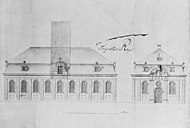Reithaus (Leipzig)
For 150 years from 1718 the riding house in Leipzig offered the possibility of riding in the city regardless of the weather.
Location and shape
The Riding House was located between the Ranstädter Gate , which existed until 1828, and in 1766 on the former Rannischen Bastion -completed Old Theater . This place was the space between the inner and outer city wall ( Zwinger ). Today the place corresponds to the confluence of the footpath along the courtyards at Brühl on Richard-Wagner-Platz (until 1913 Theaterplatz).
The single-storey, baroque building , 59 cubits long, had nine window axes with high, arched windows on the long side . On the narrow sides there were gate-like entrances, surmounted by flat ornamental gables, on which the initials August the Strong with a crown were emblazoned in stone on the front and the Leipzig city coat of arms on the back. Under the hipped mansard roof with arched roof was the university stable master's apartment . The stables were a separate building. In good weather it was possible to ride behind the house.
history
The riding arena on the ground floor of a granary at the eastern end of the Brühl, which was built after the Bernhardinerkolleg was closed , was lost in 1700 when the Georgenhaus was built . After that, only a small riding arena was available in Zoten's yard .
In 1716, the city council submitted plans for a riding house to August the Strong, but the latter rejected them. Instead, he had Johann Christoph von Naumann carry out the planning in Dresden . The construction took place in 1717/1718, in which, in addition to master mason Adam Jacob, the Leipzig master builder Christian Döring was also involved. The architectural sculpture was made by the Weißenfels sculptor Johann Gottfried Griebenstein.
The riding house primarily served the riding training of the students. Although in literature riding is one of Goethe's favorite activities in Leipzig and he is associated with the Reithaus, according to his own admission, this should not necessarily be the case when he writes to his sister Cornelia from Leipzig: "I gave the concert, the comedy, completely renounced riding and driving ”. He had already learned to ride in Frankfurt .
After the opera at Brühl was demolished in 1720 and until the opening of the Old Theater in 1766, the Reithaus was used for opera performances during masses, especially by Italian theater groups, for which it was structurally adapted in 1744.
In 1821 the stable building adjacent to the theater was re-performed and the university stable master's apartment was moved here. Towards the end of the 1860s, the Reithaus was in the way of the expansion of Theatergasse, which later became Richard-Wagner-Strasse, and was therefore demolished in 1868.
literature
- Peter Schwarz: Millennial Leipzig. From the beginning to the end of the 18th century . 1st edition. tape 1 . Pro Leipzig, Leipzig 2014, ISBN 978-3-945027-04-2 , pp. 372/373 .
- Gustav Wustmann : Picture book from the history of the city of Leipzig for old and young . Leipzig 1897, p. 57
Web links
Individual evidence
- ↑ Gina Klank, Gernoth Griebsch: Encyclopedia Leipziger street names . Ed .: City Archives Leipzig. 1st edition. Verlag im Wissenschaftszentrum Leipzig, Leipzig 1995, ISBN 3-930433-09-5 , p. 177/178 .
- ↑ May, Walter: Naumann, Johann Christoph von. In: New German Biography (NDB). Volume 18, Duncker & Humblot, Berlin 1997, ISBN 3-428-00199-0 , p. 770 f. ( Digitized version ).
- ↑ Contract of the Weißenfels sculptor Johann Gottfried Griebenstein with the Leipzig council for the production of the decorative sculpture for the riding house in Leipzig, December 10, 1717. In: SLUB Dresden. Retrieved March 10, 2019 .
- ↑ Ursula Brekle: Johann Wolfgang von Goethe. In: Leipzig reading. Retrieved March 11, 2019 .
- ↑ Sebastian Ringel: How Leipzig's inner city has disappeared . Leipzig 2018, ISBN 978-3-948049-00-3 , p. 26
- ↑ 1767 To Cornelia Goethe. Retrieved March 11, 2019 .
- ^ Peter Schwarz: The millennial Leipzig. From the beginning to the end of the 18th century . 1st edition. tape 1 . Pro Leipzig, Leipzig 2014, ISBN 978-3-945027-04-2 , pp. 372 .
- ^ Gottfried Wilhelm Becker : Painting of Leipzig and its surroundings for foreigners and locals. Leipzig 1823, p. 94 (digitized version)
Coordinates: 51 ° 20 ′ 38 " N , 12 ° 22 ′ 20.4" E



